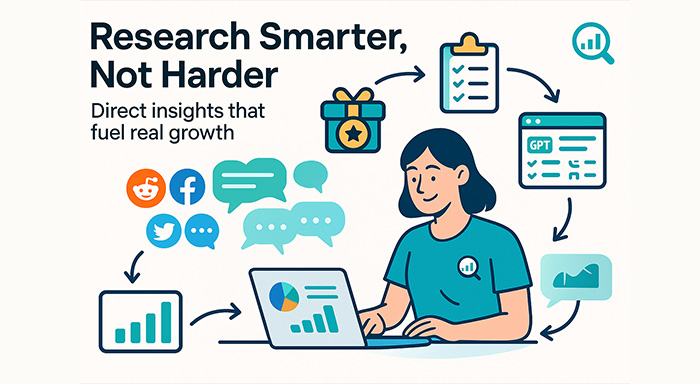Every marketing specialist knows that knowing your customer is the key to success. Every campaign aims to recognize consumer needs (or wants) and target them in a relatable and organic manner. Yet, industry leaders already have a stable position in the market and can spare no expense on market research.
For smaller businesses and startups, conducting market research is primarily about achieving effectiveness at a low cost. Thus, let’s review some of the practical suggestions for conducting market research without violating your budget.
The need for market research
Market research shapes every business decision (to a degree). For example, by reviewing your competitors' branding decisions, style, and advertising angles, you can already see what works. In the beginning, smaller companies usually don’t attempt to “break the wheel.” Instead, they adapt to the market, using the gathered insights to shape their own propositions to consumers.
Conducting a thorough market research plan enables you to identify your audience, understand the messages they respond to, and determine their priorities. For example, businesses can ask the right questions and experiment within certain boundaries.
Take advantage of publicly available studies
The first stop for every small business conducting market research will be internet resources. Dozens of companies and organizations observe the market and invest substantial effort in providing these insights. They typically cover general industry trends, demographics, conversion rates, success/failure stories, and market share. Secondary research is essential for providing context and helping you determine where your product fits.
For example, the study from Paddle is one of the informative options you can access without spending a dime. It introduced the mobile app monetization trends for 2025 and would have served as practical assistance for anyone attempting to implement monetization strategies for their software products.
In other cases, you may need to pay to access the entire report and explore its findings in more detail. Create a spreadsheet and collect all available market reports related to your areas of interest.
Competitor analysis
Knowing your enemies (competitors) is the greatest weapon when marketing your products or services. It helps your company establish the following goals and perceptions:
- The current market leaders’ offers to their clients.
- The business strategies (such as advertising campaigns or partnerships) that they use.
- Gaps in the industry and reported complaints.
- Pricing capabilities and trends.
- Customer support approach.
- Design and UX preferences.
- Growth opportunities.
- Common mistakes.
Conduct primary research

Primary research involves collecting information directly and analyzing it to draw conclusions and statistics. Instead of seeing generalized information, you can get into specifics and directly address your product/service. While this is preferable and more useful for market research, it’s also more challenging to obtain.
Direct responses/opinions from current clients
It could relate to utilizing your current user base. For example, you can include questionnaires for your users in your application or official website. Then, you can inquire about specific things that are directly related to your plans. Yet, consumers typically do not want to complete these additional surveys. So, if you’re asking for opinions via your service, consider what motivational factors could help.
Many e-commerce platforms encourage feedback on their products through reward systems. Similar approaches can be taken, such as unlocking additional perks or enjoying premium access for an extended period of time. If possible, tempt consumers with merchandise, suggesting that lucky participants will receive such items as a reward.
Assistance from Get-Paid-To (GPT) websites
Get-Paid-To (GPT) platforms pay consumers for participating in different types of market research. So, it has become a stable way to earn money online without having specialized skills or investment. So, services like JumpTask are attractive to users who have some spare time. Then, they can respond to surveys, train AI, watch ads, test apps, and more. For marketers, GPT websites could be the perfect collaboration.
Essentially, companies partner with GPT services and provide them with tasks that require completion. For example, it could be a market research survey designed to gather insights from consumers. If needed, GPT websites can also screen potential participants based on different demographics. Then, you can receive responses and opinions from people you want.
Research via social networks
Social networks and forums can serve as one method for gathering users’ opinions. You can collect them from previous discussions, or be the one to start them. Through Reddit posts, you can discover unfiltered statements that could provide more genuine insights into your interest areas.
Related Read: Social Proof in Marketing: Leveraging User Trust for Growth
Don’t forget Google Analytics
Google Analytics can provide general insights into the demographic data of your visitors and potential clients. Furthermore, you can see which content receives the most traffic, which could suggest potential growth opportunities. Learning how to use Google Analytics properly does mean improving user behavior flow and effectively adjusting to it.
Do market research with predetermined questions
If you’re diving deep into the market, try to come up with questions or hypotheses you wish to debunk or prove. It can help keep your research grounded and prevent you from losing track of your interests.
Note down your assumptions about the current market and your competitors. They may relate to pricing challenges or opportunities in affiliate/influencer marketing.
Devising your assumptions or predictions allows you to ask the right questions and gain more clarity on the most critical aspects of your business.
The market never stands still
While some industries and markets advance more rapidly than others, all are susceptible to change. So, even if you have managed to reach a comfortable stage with your market research, the bad news is that it may already be outdated (at least to some degree). Consumer perceptions and opinions shift daily, and companies shouldn’t aim to address every fluctuation. Instead, prepare plans to conduct regular market research, but staying in touch with current trends should be a daily task.
Conclusion
Market research is truly a mountain. With limited resources, climbing it means doing it without special equipment. However, even if you have limited resources, you can get ahead with secondary research, competitor analysis, or even low-cost primary research options. Furthermore, don’t forget to utilize your current user base and rely on them for continuous feedback. Lastly, the market is ever-growing; thus, your efforts should also adapt to the newest developments!



